List of Indian Missiles like BrahMos, Shaurya, and S-400 showcase India's defence strength. Explore the complete List of Indian Missiles 2025 with names, types, ranges, and recent developments across all missile categories.
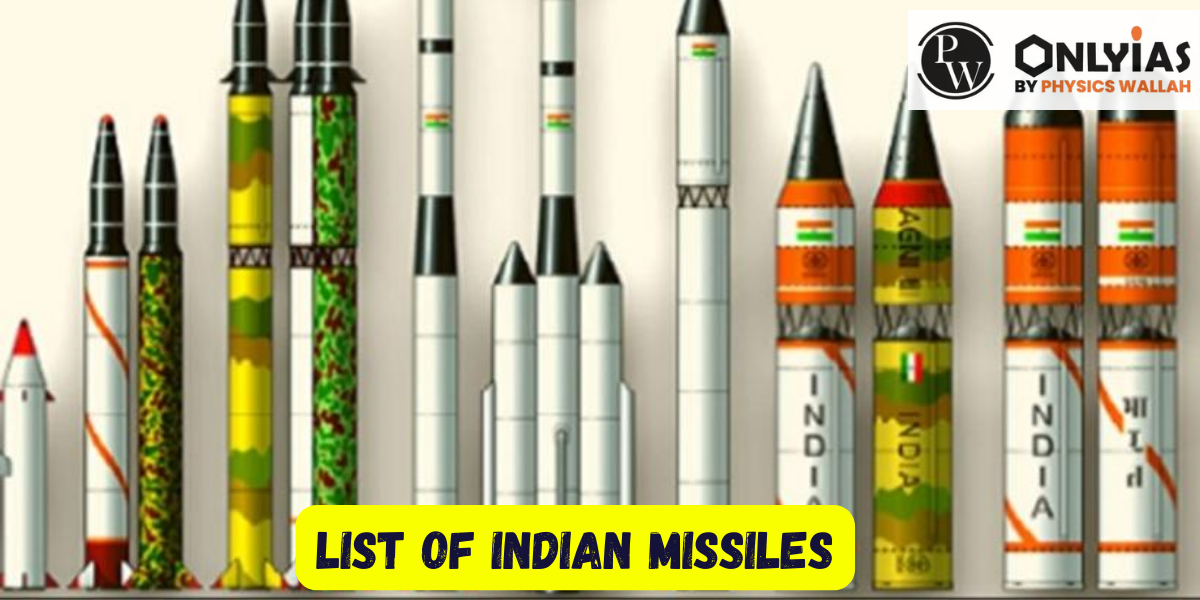
In military terminology, a guided missile is often referred to simply as a missile. It is a self-propelled airborne weapon that typically operates using a fighter jet engine or rocket motor. In everyday language, a missile is any object that can be launched, shot, or propelled towards a target. Defense-related topics, including missiles, are crucial components of various competitive tests and are often included in the General Knowledge section. In this article we will look at the Types and List of Indian Missiles.
Also Read: UPSC Prelims Admit Card 2025
India’s missile program serves multiple defense-related purposes. Its ballistic missiles form the basis for delivering nuclear weapons to both China and Pakistan. India’s focus on developing longer-range ballistic missiles and diversifying delivery methods beyond mobile land-based platforms is driven by military requirements.
To keep up with modern warfare, India has collaborated with Russia to develop cruise missiles and ship-launched ballistic missiles, aiming to bolster its military capabilities and establish itself as a strong nation.
India has made significant advancements in missile technology, bolstering its defense capabilities and strategic deterrence. With a diverse range of missile systems, the country has achieved self-reliance in this crucial area of defense. From surface-to-air missiles for aerial defense to submarine-launched ballistic missiles for maritime security, India’s missile arsenal encompasses various categories that play a vital role in safeguarding the nation’s interests. This article explores the different types of missiles deployed by India, highlighting their roles and contributions to the country’s defense strategy.
1. Surface-to-Air Missiles (SAM)
2. Air-to-Air Missiles (AAM)
3. Surface-to-Surface Missiles
4. Ballistic Missile Defence (BMD)/Interceptor Missiles
5. Cruise Missiles
6. Submarine Launched Ballistic Missiles
7. Anti-Tank Missiles
Look at the table to know each type of missiles used in India with description:
Types of Indian Missiles |
|
|---|---|
| Type of Missile | Description |
| Surface-to-Air Missiles (SAM) | Missiles are designed to intercept and destroy airborne threats. |
| Air-to-Air Missiles (AAM) | Missiles are launched from aircraft to engage aerial targets. |
| Surface-to-Surface Missiles | Missiles are designed to strike targets on land or at sea. |
| Ballistic Missile Defence (BMD) / Interceptor Missiles | Missiles designed to intercept and destroy incoming ballistic missiles. |
| Cruise Missiles | Missiles with long-range capabilities, flying at low altitudes, used for precision strikes on land or sea targets. |
| Submarine-Launched Ballistic Missiles | Missiles are launched from submarines to strike targets on land. |
| Anti-Tank Missiles | Missiles specifically designed to target armoured vehicles. |
India’s missile arsenal plays a crucial role in its defence strategy, primarily serving as a nuclear deterrent against its main adversaries, Pakistan and China. To bolster its capabilities, India has been focused on developing longer-range missiles and expanding its delivery platforms, including ship- and sub-launched ballistic missiles in collaboration with Russia.
While these efforts align with India’s minimum deterrence doctrine, the ongoing development of its missile arsenal may also lead to potential changes in its nuclear doctrine. Notably, India’s investment in multiple independently-guided reentry vehicle (MIRV) technology indicates a possible evolution in its nuclear strategy. However, despite these advancements, there is no substantial discussion in India about deviating from its declared no-first-use policy.

Air-to-Air missiles are guided missiles launched from aircraft to engage enemy airborne targets. They ensure aerial superiority and come in various types, equipped with advanced guidance systems and warheads for maximum effectiveness. These missiles play a crucial role in modern air combat, enhancing the capabilities of fighter aircraft to neutralize airborne threats.
| Air-to-Air Missiles | ||
|---|---|---|
| Name of the Missile | Type | Range |
| Astra | Air-to-Air Missiles | 500 m to 340 km |
| MICA | Air-to-Air Missiles | 500 m to 80 km |
| Novator K-100 | Medium Range (Inertial navigation and active radar homing) | 300–400 km |
| Astra Mk1 | Long-range radar-guided | 110 km |
| Astra Mk2 | Long-range radar-guided | 160 km |
| Astra Mk3 | Long-range radar-guided | 350 km |
| Solid Fuel Ducted Ramjet | Long-range Missile | 350 km |

Surface-to-Air Missiles (SAMs) are defensive weapons designed to intercept and destroy enemy aircraft, missiles, or drones. They are launched from the ground and equipped with radar and guidance systems to track and engage aerial threats. SAMs are essential for protecting military installations, cities, and key assets from airborne attacks.
| Surface-To-Air Missiles | ||
|---|---|---|
| Missile Name | Type | Range |
| VSHORAD | Very Short Range Air Defence | Up to 15 km |
| Akash | Medium-Range Surface-to-Air Missile | 25–30 km |
| Akash-NG | Medium-Range Surface-to-Air Missile (Next Generation) | 30–40 km |
| QRSAM | Quick Reaction Surface-to-Air Missile | 25–30 km |
| VL-SRSAM | Vertical Launch Short Range Surface-to-Air Missile | 15–20 km |
| SAMAR Air Defence System | Short/Medium-Range Air Defence System | 20–40 km |
| MR-SAM | Medium-Range Surface-to-Air Missile | 70–100 km |
| LR-SAM | Long-Range Surface-to-Air Missile | 150–200 km |
| MR-SAM (Alternate) | Medium-Range Surface-to-Air Missile | 70–100 km |
| ER-SAM | Extended-Range Surface-to-Air Missile | 150–200 km |
| XR-SAM | Extended-Range Surface-to-Air Missile | 250 km |
| Prithvi Air Defence (PAD) | High-Altitude Air Defence (ABM) | 50–80 km |
| Advanced Air Defence (AAD) | High-Altitude Air Defence (ABM) | 70–80 km |
| Prithvi Defence Vehicle (PDV) | Anti-Ballistic Missile Defence | 200–300 km |
| Prithvi Defence Vehicle Mark 2 (PDV Mk 2) | Anti-Ballistic Missile Defence | 300–400 km |
| AD-1 Missile | Advanced Air Defence Missile | 50–80 km |
| AD-2 Missile | Advanced Air Defence Missile | 80–100 km |
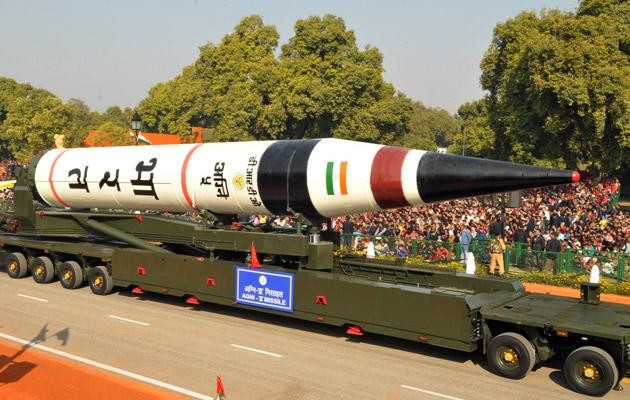 Surface-To-Surface Missiles
Surface-To-Surface Missiles
Surface-to-Surface Missiles (SSMs) are guided missiles designed to be launched from land-based platforms to strike targets on the ground. They are typically used for strategic strikes against military targets, infrastructure, and enemy installations. SSMs can vary in range, from short-range tactical missiles to long-range strategic weapons, and are equipped with high-explosive or nuclear warheads, depending on the missile’s role and intended target.
| Surface-To-Surface Missiles | ||
|---|---|---|
| Name of the Missile | Type | Range |
| Agni-I | Medium-range ballistic missile | 700-1250 km |
| Agni-II | Intermediate-range ballistic missile | 2,000–3,000 km |
| Agni-III | Intermediate-range ballistic missile | 3,500 km – 5,000 km |
| Agni-IV | Intermediate-range ballistic missile | 3,000 – 4,000 km |
| Agni-V | Intercontinental ballistic missile | 5000 – 8000 km |
| Dhanush | Short-Range Ballistic Missile | 350 – 600 km |
| Prahaar | Short-Range Ballistic Missile | 150 km |
| Prithvi I | Short-Range Ballistic Missile | 150 km |
| Prithvi II | Short-Range Ballistic Missile | 350 km |
| Shaurya | Medium-Range Ballistic Missile | 750 to 1,900 km |

Cruise missiles are self-propelled, guided missiles designed for long-range precision strikes against fixed and mobile targets. They can travel at subsonic or supersonic speeds, and their advanced navigation systems allow them to follow a pre-programmed flight path or adjust in real-time based on target coordinates. Cruise missiles are highly versatile, capable of carrying conventional or nuclear warheads and used in various military operations for strategic and tactical purposes.
| Cruise Missiles | ||
|---|---|---|
| Missile | Type | Range |
| BrahMos Block I | Supersonic ship-launched anti-ship / land-attack cruise missile | 290 km |
| BrahMos Block I (Land-launched) | Supersonic land-launched land-attack / anti-ship cruise missile | 290 km |
| BrahMos Block II | Supersonic land-launched land-attack / anti-ship cruise missile | 290 km |
| BrahMos Block III | Supersonic land-launched land-attack / anti-ship cruise missile | 290 km |
| BrahMos-A | Supersonic air-launched land-attack / anti-ship cruise missile | 400 km |
| Submarine-launched BrahMos | Supersonic land-launched land-attack / anti-ship cruise missile | 290 km |
| BrahMos ER | Multi-platform multirole supersonic cruise missile | 600 km |
| BrahMos NG | Multi-platform multirole supersonic cruise missile | 290 km |
| BrahMos II | Hypersonic cruise missile | 300 km |
| Nirbhay | Subsonic cruise missile | 1,000 – 1,500 km |

Defense missiles are advanced weapon systems designed to intercept and destroy incoming enemy threats, such as missiles, aircraft, or projectiles. They form a critical part of a country’s defence strategy, providing protection against potential attacks and enhancing national security. Defence missiles come in different types, including surface-to-air missiles (SAMs), surface-to-surface missiles, and ballistic missile defence (BMD) systems, each tailored for specific defense needs. These sophisticated weapons use advanced tracking, guidance, and propulsion technologies to ensure accurate targeting and successful interception of potential threats.
| Defense Missile | ||
|---|---|---|
| Missile | Type of Missile | Range |
| Advanced Air Defence | Endoatmospheric Anti-ballistic missile | 300 km – 2,000 km |
| Prithvi Air Defence | Exo-atmospheric Anti-ballistic missile | 150 km |
| Prithvi Defence Vehicle | Exo-atmospheric Anti-ballistic missile | 2,000 km |
| Prithvi Defence Vehicle Mark-II | Exo-atmospheric anti-ballistic missile | – |
| AD-1 | Anti-ballistic missile | 5,000 km |
| AD-2 | Anti-ballistic missile | – |
 Submarine Launched Ballistic Missiles
Submarine Launched Ballistic Missiles
Submarine Launched Ballistic Missiles (SLBMs) are ballistic missiles deployed on submarines, providing nations with a second-strike nuclear capability. These missiles can be launched from underwater, making them difficult to detect and giving submarines strategic importance in nuclear deterrence. SLBMs have the ability to carry nuclear warheads over long distances, adding to a nation’s overall defense capabilities.
| Submarine Launched Ballistic Missiles | ||
|---|---|---|
| Name of the Missile | Type | Range |
| Ashwin | Ballistic Missile | 150-200 km |
| K-4 | Ballistic Missile | 3,500–5,000 km |
| K-5 | Ballistic Missile | 6,000 km |
| Sagarika | Ballistic Missile | 700 – 1900 km |
Anti-Tank Missiles are precision-guided munitions designed to destroy armored vehicles and tanks. These missiles are highly effective against heavily armored targets and are usually launched from ground-based platforms or helicopters. They play a vital role in modern warfare, providing infantry and armored units with a powerful and versatile weapon to counter enemy tanks and armored vehicles.
| Anti-Tank Missile | ||
|---|---|---|
| Name of the Missile | Type | Range |
| Amogha | Anti-Tank Guided Missile | 2.8 km |
| Helina | Anti-Tank Guided Missile | 7-8 km |
| Nag | Anti-Tank Guided Missile | 4 km |
As of 2025, India continues to strengthen its defence capabilities with cutting-edge missile systems. The List of Indian Missiles now includes highly advanced technologies, such as hypersonic and subsonic cruise missiles, precision tactical missiles, and improved air-to-air and surface-to-air missile systems. These missiles, like the List of Indian Missiles above, enhance India’s strategic defence prowess, with innovations aimed at securing both land and maritime borders.
| Latest Indian Missiles Launched or Commissioned | |||
|---|---|---|---|
| Missile Name | Type | Range | Key Features |
| Nirbhay | Subsonic Cruise Missile | 1,000 km | India’s first long-range cruise missile with both land and sea attack capabilities. |
| Shaurya | Hypersonic Surface-to-Surface Missile | 800 km | Canister-launched, hypersonic speed with nuclear or conventional warhead options. |
| Astra Mk II | Air-to-Air Missile (BVR) | 160 km | Enhanced beyond visual range missile with better guidance and range. |
| Pralay | Tactical Ballistic Missile | 150–500 km | Precision strike capability for tactical military operations, mobile-launched. |
| Vikrant Cruise Missile | Air-Launched Cruise Missile | 350 km | Naval missiles designed for land and sea strikes were launched from fighter jets. |
| MR-SAM (Version 2) | Surface-to-Air Missile | 70–100 km | It’s an upgraded version with better interception abilities against modern threats. |
| BrahMos NG | Supersonic Cruise Missile | 290 km | Next-gen lighter version for mobile launch platforms with enhanced manoeuvrability. |
India, as a nation, has always been committed to ensuring its security and sovereignty. In the pursuit of this goal, the country has made significant strides in developing advanced missile technology. India’s indigenous missile program has been pivotal in strengthening its defence capabilities and ensuring deterrence against potential threats. In this article, we will explore the various categories of Indian missiles, each designed to serve specific purposes and bolster the nation’s defence.
Ballistic missiles are propelled in a high trajectory and rely on gravity to strike their intended target. India has made remarkable progress in developing ballistic missiles, both short and long-range.
Agni Series: Agni missiles are long-range ballistic missiles and form the backbone of India’s nuclear deterrence. The series includes Agni-I (700 km range), Agni-II (2,000 km range), Agni-III (3,000 km range), Agni-IV (4,000 km range), and Agni-V (5,000 km range). Agni-V, with its Intercontinental Ballistic Missile (ICBM) capability, is a testament to India’s advanced missile technology.
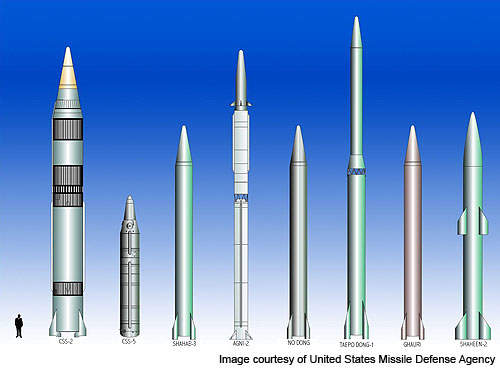
Prithvi Series: The Prithvi missiles are short-range ballistic missiles and come in various variants like Prithvi-I (150 km range), Prithvi-II (250 km range), and Prithvi-III (350 km range). These missiles are known for their tactical advantages and quick deployment.

Shaurya
Range: 700–800 km | Speed: Mach 7
A hypersonic, canister-launched surface-to-surface missile developed by DRDO. Known for high manoeuvrability and stealth, it serves as a potent nuclear deterrent.

Cruise missiles are guided missiles that can travel at low altitudes and can be programmed to follow specific flight paths. India has been actively developing cruise missiles for its tactical and strategic needs.
BrahMos: The BrahMos missile, developed jointly with Russia, is one of the fastest supersonic cruise missiles in the world. With its versatile land, sea, and air variants, BrahMos has significantly enhanced India’s precision strike capabilities.

Nirbhay: Nirbhay is India’s indigenously developed subsonic cruise missile with a range of over 1,000 km. It offers the flexibility of striking multiple targets with pinpoint accuracy.

Anti-Tank Guided Missiles are designed to destroy armoured tanks and fortified structures. India has actively developed and deployed ATGMs to counter any armoured threats.
Nag: Nag is a third-generation fire-and-forget ATGM with top-attack capability. It has been successfully integrated into India’s armoured forces.
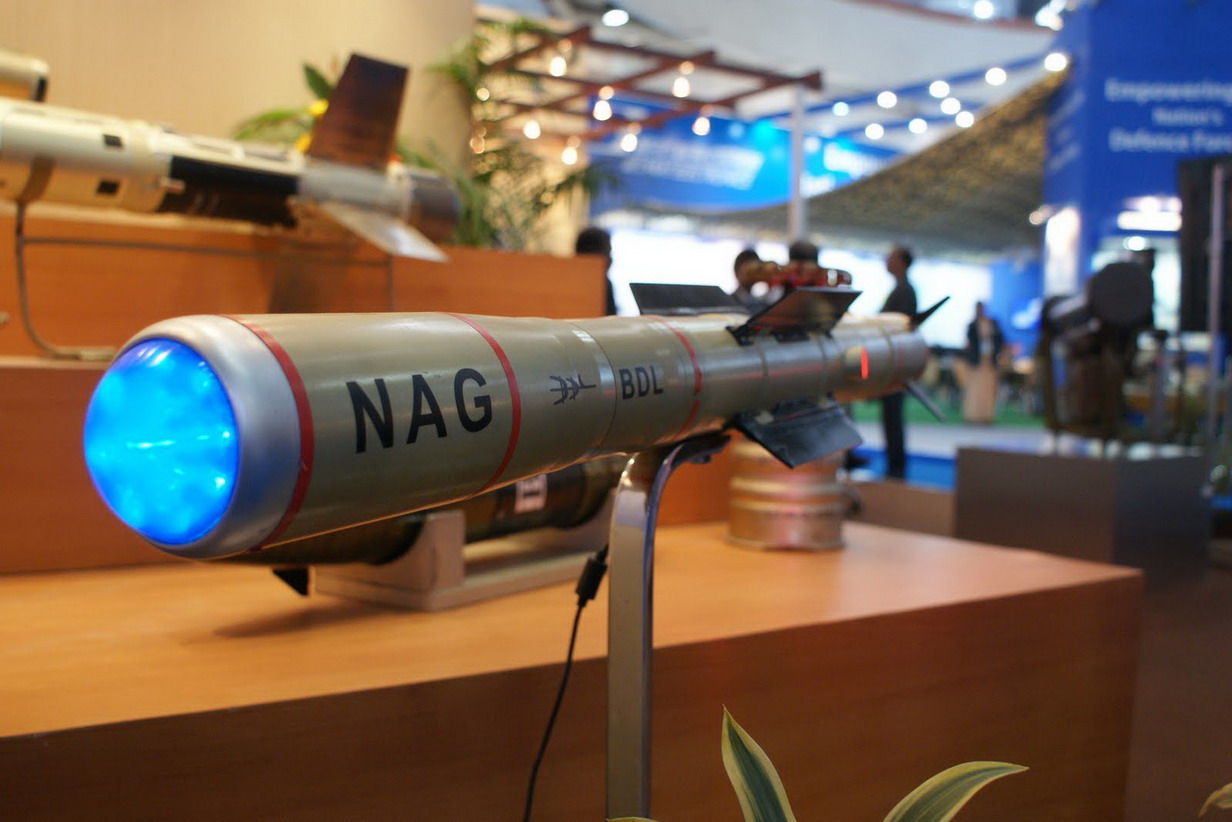
Spike
Range: 2.5–4 km | Speed: Mach 2
An Israeli man-portable anti-tank guided missile system used by Indian forces for precision targeting of armoured vehicles and bunkers.
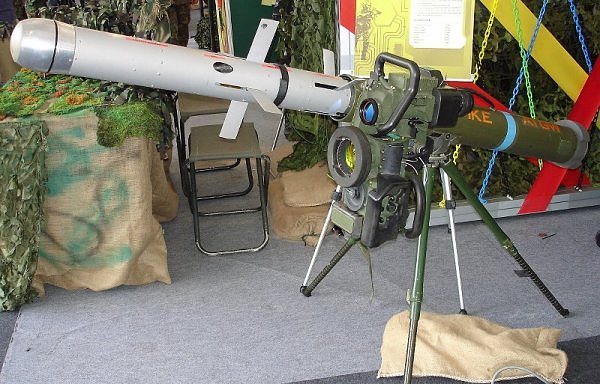
Surface-to-Air Missiles are designed to intercept and destroy incoming enemy aircraft, missiles, or drones.
Akash: Akash is a medium-range SAM system capable of engaging multiple aerial targets simultaneously. It is an essential component of India’s air defense network.

Barak-8 (LRSAM/MRSAM)
Range: 70–100 km | Speed: Mach 3
An Indo-Israeli surface-to-air missile system designed to counter airborne threats including aircraft, UAVs, and missiles. It is deployed by all three Indian military services.

SPYDER
Range: 20–50 km | Speed: Mach 4
A quick-reaction surface-to-air missile system developed by Israel, capable of engaging multiple aerial targets with high accuracy using radar and IR guidance.

S-400 Triumph
Range: Up to 400 km | Speed: Mach 14
Russia’s advanced long-range air defence system capable of intercepting aircraft, cruise, and ballistic missiles. It forms a key part of India’s multi-layered air defence.
Trishul: Trishul is a short-range SAM system designed to intercept low-flying enemy aircraft and missiles. However, it was discontinued after initial development.

BrahMos (Naval Variant)
Range: 300 km | Speed: Mach 2.8–3
A supersonic cruise missile jointly developed by India and Russia, the naval variant is deployed on ships and submarines for high-speed strikes on sea and land targets.

Dhanush
Range: 350 km | Speed: Mach 2
A ship-launched ballistic missile derived from Prithvi, Dhanush enhances the Indian Navy’s ability to strike both naval and coastal targets.

Varunastra
Range: 40 km | Speed: Subsonic
An indigenous heavyweight torpedo designed for anti-submarine warfare, capable of autonomous targeting and launched from ships and submarines.
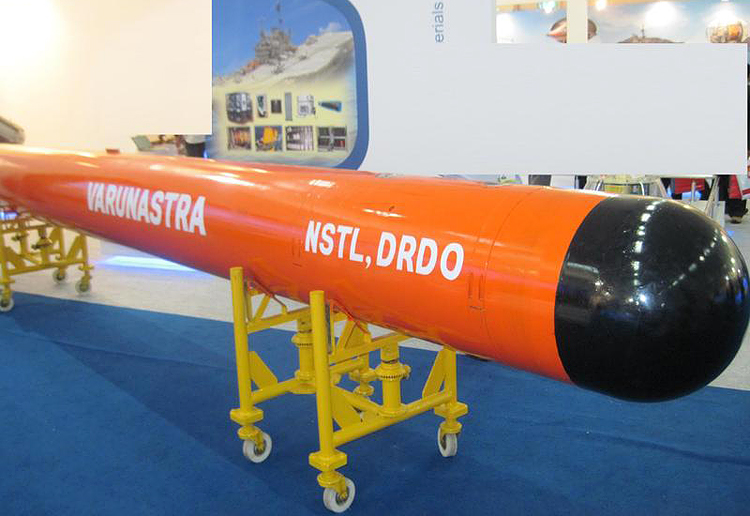
Lakshya
A subsonic aerial target drone developed by DRDO, used by the Indian Armed Forces for realistic live-fire training of surface-to-air and air-to-air missile systems.

Abhyas
An expendable high-speed aerial target system derived from Lakshya, used for testing and validating surface-to-air missiles and radar tracking efficiency.

India’s journey in missile development has been a testament to its commitment to safeguarding its national security. The list of Indian missiles showcases the nation’s indigenously developed and cutting-edge technology, which has earned it a place among the top missile-capable countries in the world. With ongoing research and development, India continues to reinforce its defence capabilities, ensuring a secure future for its citizens and the nation as a whole.
1. The Integrated Guided Missile Development Program (IGMDP) was launched in 1983.
2. The program aimed to develop Trishul, Akash, Nag, Prithvi, and Agni-I missile systems.
3. Tessy Thomas, known as the “Missile Woman” of India, served as the Project Director for Agni-IV in DRDO.
4. Prithvi was India’s first surface-to-surface missile with single-stage and liquid fuel technology.
Ready to boost your UPSC 2025 preparation? Join PW’s UPSC online courses today!
UPSC Exam 2025 Related Articles
UPSC Prelims 2025 Exam
UPSC Notification 2025
UPSC Preparation 2025
UPSC Eligibility 2025
UPSC Exam Pattern
UPSC Syllabus
Agni-V, developed by the DRDO, is an Indian nuclear-capable intercontinental ballistic missile with a range of approximately 5,000 to 5,500 kilometers. Some scientists and experts suggest that its actual range could be as much as 8,000 kilometers.
Indian missiles can be classified into five types: air-to-air, air-to-surface, surface-to-air, anti-ship, and anti-tank.
As part of the IGMDP, India successfully developed five distinct missile systems: Trishul, Akash, Nag, Prithvi, and Agni-I. These missiles serve various military purposes, including air defense, anti-tank, and surface-to-surface capabilities.
The four names of Indian missiles are: Agni, Akash, Prithvi and Nag.
Agni-V, an intercontinental ballistic missile (ICBM) developed by India's DRDO, is capable of carrying nuclear warheads and has a range of over 7,000 kilometers. According to some Chinese researchers, it may even have a range of 8,000 kilometers.

<div class="new-fform">
</div>